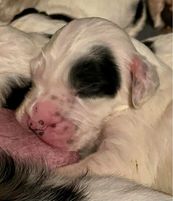The incomparable A.B. Frost
Before I went to the dogs, I went to the library. I had no background in bird hunting, so I did the only thing I knew to do - go find a book about it.
What I found were gun dog training books written primarily by men who made their bones and their reputation running field trials. So my foundation in the sport had a slightly whitewashed view, especially about the color of a bird dog...
You want all the white on a dog you can get, they wrote. A dark head is fine (but only if it's an even mask), but all other things being equal, you want the brightest white one you can find when choosing a prospect. Visibility when you’re scouting that “out on a limb” find in big country is key. Bright shiny objects burning up the far horizon or cutting swaths through the grouse woods make judges sit up straighter in the saddle. Maybe all that shine is a liability against the snow, but that’s why the gun dog supply houses sell those wide fluorescent collar sleeves, right?
I found George Evans in a copy of Gun Dog magazine I "liberated" from the men's room of a Kentucky shooting preserve. George made color kind of a cult thing with his Old Hemlocks, waxing rhapsodically about elegant “snow beltons” - even though Wilda and at least a couple of his early dogs were quite intensely ticked. If one reads enough GBE, a fella can start believing that solid body markings are almost bar sinister.
I suppose there is simply no accounting for taste. After all of that shaping by my betters, I never could resist distinctive markings on a bird dog.
In the end, though, “Pretty is as pretty does.” Performance coupled with a hardy, athletic physique, topped off with companionable disposition matters far more than colored hair swatches, but for what it’s worth and all else being equal...
Give me a big spot setter dog every time. The more markings, the merrier.
I want eye pigmentation, too, in part because I like the way those dark eyes reflect a dog’s soul and mine. I’m also a believer in the research done with pie-bald patterned animals that associates light eyes and lack of body patches with deafness, a condition which stalks our English setters, too. I have also seen enough sunburned noses when we hunted the High Plains to prefer dark pigmentation there, too.
Le Grande Orange: Firelight Seth
But that's as much practicality as I can manage in what is mostly a silly matter of personal prejudice. Oh, I am sure part of that was shaped by the upland artwork I have loved from the start. Foster, Osthaus, the brilliant A.B. Frost -all put color on their bird dogs. John M. Tracy, (1843-1893), the designer of the American Field masthead, was another who painted the transition from the heavier coated, body- patched Llewellin influenced imports to the flashy mostly white rock stars that have wowed field trial galleries for over a century.
Osthaus could always capture a dog's eye.
Five or six years ago, Lynn Dee Galey sent me a picture Walt Lesser had shared with her, a shot of a dark, handsome athlete named Dawn's Shadbush Ted. Ted partnered with Walt in the '80's and earns his own section in the book The Real Ryman Setter. The photo below was used in that invaluable book.
Dawn's Shadbush Ted
At the time, Lynn Dee mentioned that by appearance and by Walt's description of Ted's performance, the dog was a model for much of what she was trying to do with her own Firelight breeding. Since then, I have kept Ted's photo on my phone as a ready reminder of what I love most about heavily marked English setter gun dogs.
So to the Only Body White is Right setter crowd, please forgive my love for the tick-tarted, tri-color Dreamboat Annie, the exotic Clementine, with her 1/8 Llewellin flava, the almost roan look of Lynn Dee's little female, Moondance. Indulge me when I dote on Firelight Seth, heir to Rusty Staub’s handle, Le Grande Orange, only the second orange setter I’ve ever managed to love. All of 'em pass the look test on their way to the grouse woods.













No comments:
Post a Comment